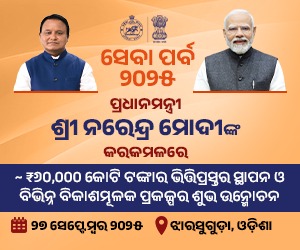Kendrapara: A legal practitioner has spent over three decades pursuing a passion that he has cultivated over the years in order to build a mini museum housing rare coins and antique items in Kendrapara.
Mohammed Mustaque (51) of Fakirabad village in Kendrapara town, has carved out an identity for himself through his museum which draws several visitors. For decades, Mustaque has been preserving coins, rare documents, photographs, newspapers, journals and letters of historical importance.
“Since childhood, I’ve been an ardent lover of antique items and developed an interest in numismatics. It was three decades of perseverance and hard work that is now paying dividends,” Mustaque said.
Mustaque has spent heavily out of his pocket in order to fuel his passion. His museum collection boasts of British-era currency notes, ancient Indian currency notes and also those from the princely states of India. He also possesses several old currency notes from neighbouring nations such as Myanmar, Pakistan, Bangladesh besides uncirculated commemoratives, and mint error currency notes among others.
“I have kept old Indian currency notes when CD Deshmukh was the Governor of the Reserve bank of India both in pre–Independence era as well as after Independence. I have some pretty rare collections,” Mustaque claimed.
He also obtained Rs 1 to Rs 100 denomination currency notes in which Gandhi is depicted sitting at Sabarmati Ashram .
Before Independence, 565 princely states were officially recognised in the Indian subcontinent apart from thousands of zamindaris and jagirs. While many princely states were issuing their own coinage, only two – Jammu and Kashmir and Hyderabad – actually issued paper currency. Jammu and Kashmir began issuing paper currency in 1876 while Hyderabad began it in 1918. Mustaque possesses rare imprinted currency notes of Nizam of Hyderabad – Mir Osman Ali, who was the richest Nizam in the country during that period, said Mustaque.
“I possess several Indo-Pak currency notes. During the partition, a sum of Rs 75 crores was set aside for the newly-formed Pakistan as part of the compensation to be paid by the Indian government. The first installment of Rs 20 crores was paid; but then the Pakistani Army invaded Kashmir which had acceded to India at the time, and the Indian government refused to hand over the balance of Rs 55 crores, asking for the Kashmir issue to be resolved first, since any money given to Pakistan would probably be used for military purchases and used against India. Gandhi was against this decision and argued that this meant going back on an agreement made in earnest and not a good beginning for relations between two newborn countries, and undertook a fast to insist on paying the agreed upon money. Later, the Indian government provided the money.
There was only one government press that printed currency notes and India refused to hand that over. So Pakistan began its existence with Indian currency notes rubber stamped “Pakistan” over “India” in 1948,” said Mustaque.
With an aim to promote Khadi clothes and Khadi articles , the Indian government in the 1960s issued Khadi commission notes called Khadi hundi. Denominations of Rs 2,5,10 and 100 in designs have also earned pride of place at his museum, which is a rare currency, said Mustaque.
During the Second World War, many petty princely states issued emergency tokens which are alluded to as ‘cash coupons’ in lieu of coins. The rarest and valuable princely state token money too has also been kept in his museum along with Indo-Burmees currency notes.
The rarest among the coins was ‘pig rupees’. King Edward VII died May 6, 1910 and was succeeded by his son King George V, who was coronotated June 22, 1911. Coins were minted in India with the effigy of King George V from 1911 to 1936.On the 1911 issues of the Rupee, Half Rupee, Quarter Rupee, Two Annas and 1/4 Anna the King is shown wearing a robe with a small elephant on it. This elephant was thought to resemble a pig with the trunk appearing to be a pig snout and the short legs not appearing very elephant-like. This offended the religious sensibilities of many, so most of the Rupees minted for 1911 were withheld from circulation and later melted. The 1912 coins had a redesigned elephant, said Mustaque.
The 100 denomination Rubel note published in 1898 and 1910, which is said to be the world’s largest note as its 25.5412 centimetres, also got a place in his museum apart from mint error notes and uncirculated commemorative coins ,said Mustaque. As the Rs 500 and Rs 1,000 notes are no longer considered legal tender, several visitors are coming to his museum to see the rare old coins, said Mustaque. PNN

